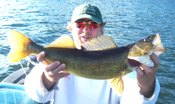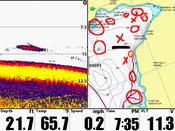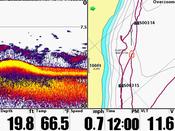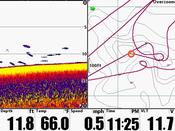 In the past week as I visited a number of lakes in Vilas and Onida County, & summer walleye patterns were strongly under way. We have had such unusual spring with early sky rocketing temps, then a late May cool down. To increase the challenge, we have been badgered by nearly daily rain which lowered the water temps even more.
In the past week as I visited a number of lakes in Vilas and Onida County, & summer walleye patterns were strongly under way. We have had such unusual spring with early sky rocketing temps, then a late May cool down. To increase the challenge, we have been badgered by nearly daily rain which lowered the water temps even more.
Surprisingly, in most lakes I fished, weed growth was at normal to below normal growth for this time of June. So that really raised the question to where and how to find the walleyes. Generally during this week of June, dragging ringworms through cabbage and ticking cranks along the tops of deeper weeds would produce a lot of walleyes and often provide for a good daytime bite. Not the case this week!
I normally don’t concentrate my fishing efforts on these northern lakes during the summer. But with a week to fish to my heart’s content, I couldn’t quit and not get a pattern going. Without a question, the number one tool for finding fish was my electronics. Second, was understanding exactly what I was looking at on the screen. By knowing where the fish were located and seeing what “mood” they’re in, catching them became relatively easy. So for today’s report, I want to concentrate on the use of electronics and understanding what we see.
 So for today’s report, I want to concentrate on the use of electronics and understanding what we see. Every fisherman that is seriously pursuing walleyes, has a good fundamental idea of the basic structure they are searching for. There is very little time more important than putting your game plan together. Regardless of using a hard copy map, or the Lake master chip in you H/Bird 1197 it is critical for success to take the time in advance to study your locations. A rock bar is simply a pile of rock. But once you compare the contour lines, points, and inside turns and pockets, it becomes its’ own small eco-system.
So for today’s report, I want to concentrate on the use of electronics and understanding what we see. Every fisherman that is seriously pursuing walleyes, has a good fundamental idea of the basic structure they are searching for. There is very little time more important than putting your game plan together. Regardless of using a hard copy map, or the Lake master chip in you H/Bird 1197 it is critical for success to take the time in advance to study your locations. A rock bar is simply a pile of rock. But once you compare the contour lines, points, and inside turns and pockets, it becomes its’ own small eco-system.
The goal, is to eliminate as much un-productive water -OR- to understand where they will move to as their moods change. I selected this bay in this particular lake to research more because it appears to have everything a walleye needs in their habitat.
As soon as I launched, I was in search mode. As you can see, it was about 7:30pm and I knew I was looking for probable feeding areas as I neared the evening bite. By having my areas identified, I quickly drove by each of these spots to see what they consisted of, if fish were currently present, and if there were fish near by. I spent about 45 minutes looking over the circled areas you see. On that given day, I found a few things that keyed me into what I needed to be prepared for.
The sun had broken through the rain filled clouds, and all the fish were staged on deep flats adjacent to steep drop-offs and there were clouds of bait in the general area. ( We had an abundance of Mayflies, Dragon flies, frey, and balls of minnows in this bay)
By covering as much water as I did quickly, I had found three substantial size schools of walleyes showing a very negative mood. In all three cases, their bellies were on the bottom and even with the sidescan, there was very little separation between them and the bottom. But most importantly, there were NO suspended fish anywhere within these schools.
 It didn’t take long for everything to change as the sun began to set. As I jigged plastics to these negative fish in 28 fow, the school began to lift off the bottom. By watching the 2D sonar on my locator, I could easily identify the change in activity from negative to moderately active. The fish were now consistently 1 to 2 feet off the bottom and I was marking much less fish in 28fow.
It didn’t take long for everything to change as the sun began to set. As I jigged plastics to these negative fish in 28 fow, the school began to lift off the bottom. By watching the 2D sonar on my locator, I could easily identify the change in activity from negative to moderately active. The fish were now consistently 1 to 2 feet off the bottom and I was marking much less fish in 28fow.
From looking at everything earlier, it was effortless to know these fish were heading in shallower to a series of small humps. I also noted to myself earlier there was a lot of bait staged on these humps. As I closed in on the “spot-on-the-spot” I was marking fish from about 7′ down to 15′. The only adjustment I made was changing to a crankbait I knew would cover the 8 to 12 range. Immediate success!
Now not every school turned on at the same time. I had many evenings that I scanned a number of schools that just stayed negative. I would rotate spots, frequently checking areas I marked fish in. By seeing their un-changed relationship to tight to the bottom in deep water, I would move on to find a more active school.
 My last evening up there was probably my most productive night. We had a stiff East wind, which everyone knows the phrase “Winds from the west, fishing is the best…winds from the east, the fish bite the least!” I found myself chuckling at this phrase as I boated eye after eye. By following the same strategy I identified a school of walleyes staged deep. I checked on them a few times on other nights and they just never seemed to get fired up.
My last evening up there was probably my most productive night. We had a stiff East wind, which everyone knows the phrase “Winds from the west, fishing is the best…winds from the east, the fish bite the least!” I found myself chuckling at this phrase as I boated eye after eye. By following the same strategy I identified a school of walleyes staged deep. I checked on them a few times on other nights and they just never seemed to get fired up.
I was approaching midnight and the school of eyes that I had been fishing were fading out to a soft bite and very infrequent. So again, I moved to a school I found earlier and by watching my electronics i could see they were active. They raised high in the water column and the marks were more like blocks going across my screen.
In this case, my electronics shown me exactly where to position the boat. Having a stiff east wind down the center of this long narrow lake created more of a pain than I wanted to deal with for boat control. I opted to anchor and cast to the school. By making a couple drifts over these isolated humps, my electronics shown me most the fish were stacked up in a dip down wind of the hump.
I should note I randomly loaded some of my snapshots to illustrate my points. Since I fished a few of these lakes during the day in the rain and at night, I didn’t think at the time to capture snapshots specifically for this report. But, I also want to stress the fact it doesn’t take a $3,000.00 locator to duplicate this strategy. It is the investment of time to understand what you are seeing, relate it to their patterns, and give them the best matched presentation for that given circumstance. I duplicated this exact strategy multiple times throughout the week – and even within the same night – to have consistent success. So next time out, spend a little time narrowing down your search and you’ll spend a better quality time catching fish!
Good luck!
Randy
Here’s a few extra screen shots to help illustrate what I was looking at as I searched potential locations.